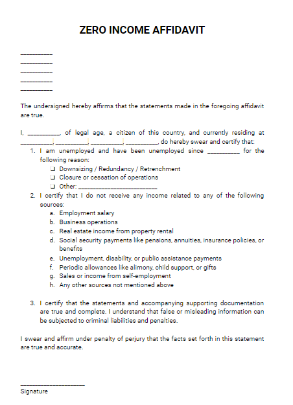- Eviction Notice Forms
- Power of Attorney Forms Forms
- Bill of Sale (Purchase Agreement) Forms
- Lease Agreement Forms
- Rental Application Forms
- Living Will Forms Forms
- Recommendation Letters Forms
- Resignation Letters Forms
- Release of Liability Agreement Forms
- Promissory Note Forms
- LLC Operating Agreement Forms
- Deed of Sale Forms
- Consent Form Forms
- Support Affidavit Forms
- Paternity Affidavit Forms
- Marital Affidavit Forms
- Financial Affidavit Forms
- Residential Affidavit Forms
- Affidavit of Identity Forms
- Affidavit of Title Forms
- Employment Affidavit Forms
- Affidavit of Loss Forms
- Gift Affidavit Forms
- Small Estate Affidavit Forms
- Service Affidavit Forms
- Heirship Affidavit Forms
- Survivorship Affidavit Forms
- Desistance Affidavit Forms
- Discrepancy Affidavit Forms
- Guardianship Affidavit Forms
- Undertaking Affidavit Forms
- General Affidavit Forms
- Affidavit of Death Forms
Financial Affidavit
In court proceedings such as divorce, the judge will ask for a sworn document from both parties to assess their financial capacity. This legal document is called a financial affidavit. It is a simple document about your financial situation which shows your income, expenses, assets, and liabilities. The contents of this affidavit depends on its purpose. Usually, it is used to calculate the amount of spousal or child support in divorce proceedings or serve as proof of financial capacity to provide financial assistance to someone. Read More

What is a Financial Affidavit?
A financial affidavit is a legal document about all of your finances circumstances. It provides details about where you earn your income and revenue, where you spend it, what your assets are, and also it lists all your debts and liabilities. In short, this document is intended to show the extent of your financial situation. This type of document is often used in divorce proceedings, bankruptcy, or in instances where you need to attest to your finances. Financial affidavit forms are normally available in court but you may also create your own or have your lawyer draft one for you.
How to write an Financial Affidavit in five steps
Financial affidavits are filled with nuances and it can be intimidating to write on your own. But you don’t have to worry, there are many forms available online that you can download and use as a reference starting point. Here are some tips on how you can properly write your own financial affidavit.
Identify the purpose of the affidavit
How your financial affidavit would look will depend on its purposes. At the onset, you have to be clear what it is all about so it would be easier for you to recall pertinent details about your finances. Financial details that you will have to disclose in the affidavit can be more or less depending on how it will be used. If it’s for a child support proceeding, it may not require a detailed list of debts and liabilities. Bankruptcy, on the other hand, will take a look at your entire financial situation, and may require a detailed list of your finances.
Identify the affiant and write a sworn statement
Identifying the affiant is the most basic element of any affidavit. In this scenario, the affiant is the one declaring their financial situation. Verifiable and personal information should be included in the affidavit such as full legal name, age, and current address. You may also include your employment details such as name of employer, address, and position held. Include a statement of truth in your affidavit to attest to the truthfulness of the details. So, make sure that the information you provided are true and correct, otherwise you will be held liable for perjury.
List down all of your financial information
As the title of the document implies, you need to specify your financial details. You can start with your income and revenue including rental, investment, employment, benefits, as well as unemployment or disability income. Next, list all salary deductions that you have like federal income tax, state income tax, health insurance, life insurance, social security, and etc. You may also include the monthly expenses you incur in your household such as mortgage, utility payments, gas, vehicle insurance, property taxes, and rent, among others.
Go over your affidavit before filing
Read through your document before you sign it and watch out for things that may not make sense or seem out of line. You may also seek legal assistance from a lawyer to review your affidavit and help you catch errors. But do not depend on your attorney so much as there will be information that’s only known to you–what might seem wrong to him, is actually correct based on your personal knowledge.
Sign and file in the court
After drafting your affidavit, it’s time to take your unsigned document to a notary, lawyer, or court clerk. Once they have determined that your affidavit is clear, accurate, and contains only the truth, you need to swear under oath and sign it in their presence. They will print their name and sign it after verifying the truthfulness of your document.
FAQs
Do all financial affidavits contain the same information?
The information required in the financial affidavit may slightly vary depending on the purpose of the affidavit and its jurisdiction. It is important to note that courts often rely on financial affidavits to get a picture of your current financial situation before making any decisions about it such as alimony, child support, division of assets, and other matters.
What happens if I cannot provide a financial affidavit?
You should keep in mind when a financial affidavit is requested, remember that the court needs it in order to make a just and equitable decision that can affect you financially. Failure to comply with this requirement can result in either of the following:
You will need to testify under oath and in person and answer all questions pertaining to your financial circumstances
The court will assume about your financial circumstances and base their decision on their assumption
You will not obtain the service of relief you are requesting from the court
What should I do if I can’t afford to pay for the filing fee to take someone to small courts?
There are financial assistance programs available in different states to help you with it. You can submit a financial affidavit along with a form that will waive court costs and fees.
What is the main purpose of a financial affidavit?
A court mandated financial affidavit will be used to take a look at your finances concerning spousal or child support allocation, bankruptcy, settlements, and even in some criminal cases
Financial affidavits is a simple document but it can be tricky to create. Make sure that you are clear in your purpose, truthful in your details, and it’s free from errors. If you lie or fail to disclose all important details, you can be charged with perjury that carries both criminal and civil consequences. Compliance to this court requirement is a must so that your current financial circumstances are considered during court decision making. To get you started, download the template available on this website now.
